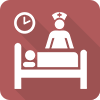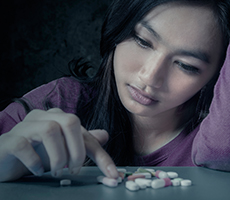- Signs and Symptoms of Ecstasy Abuse
- What are the Effects of Ecstasy Use?
- Combining with Other Substances
- Diagnosing Ecstasy Disorders
- Who is at Risk for Addiction?
- Teen Ecstasy Abuse and Addiction
- When to Seek Help
- Help for Friends and Family
- Ecstasy Rehab and Treatment Options
What is Ecstasy?
According to the American Psychological Association (APA), ecstasy, which is a common street name for 3, 4-methylenedioxymethamphetamine (MDMA), is classified as a "hallucinogen, other than phencyclidine."
Ecstasy use is marked by euphoria and feelings of hyper sexuality. Ecstasy users usually have markedly dilated pupils and may seem overly empathic, peaceful and relaxed.
Signs and Symptoms of Ecstasy Abuse
According to the National Institute on Drug Abuse (NIDA), ecstasy has physical effects similar to cocaine and amphetamines, which can include:
- Increases in heart rate and blood pressure.
- Muscle tension.
- Teeth clenching.
- Nausea.
- Chills.
- Sweating.
What are the Effects of Ecstasy Use?
Short-term effects of ecstasy use include:
- Lowered inhibition.
- Enhanced sensory perception.
- Blurred vision.
- Confusion.
- Anxiety.
Users are at risk for a sharp rise in body temperature or hyperthermia, which can impact vital organs, and can lead to organ failure or death in some cases.
Ecstasy use can also alter brain chemistry and behavior and can lead to distorted perceptions, though not quite as strongly as other hallucinogens.
Long-term effects of ecstasy use can include:
- Depression.
- Problems with attention.
- Disturbed sleep.
- Aggression.
- Loss of appetite.
- Loss of interest in sex.
These effects can occur as the drug increases the activity of the neurotransmitters serotonin, dopamine and norepinephrine. Serotonin regulates mood, emotions, memory and anxiety, therefore long-term use can affect brain structure and behavior.
Ecstasy use can have lasting detrimental effects. To learn more about treatment for ecstasy abuse, call our 24-hour hotline at
1-888-993-3112Who Answers?.
Ecstasy-Induced Hyponatremia
Ecstasy causes a rise in body temperature, which can lead the user to drink large amounts of water. This puts them at risk for ecstasy-induced hyponatremia, a condition caused by reduced sodium levels in the blood.
Severe hyponatremia can cause nausea, vomiting, muscle cramping and seizures.
Combining with Other Substances
'Date Rape' Drugs
In environments such as raves, bars and nightclubs, ecstasy users can place themselves at risk for being drugged unknowingly with Gamma hydroxybutyrate (GHB) and Rohypnol, both of which have been known to be "date rape drugs" due to their odorless, colorless and tasteless form.
GHB is a central nervous system depressant that was originally approved by the Food and Drug Administration for use in treating narcolepsy, but due to its intoxicating and sedating effects it has become a popular "club drug."
Rohypnol, or flunitrazepam--also known as Roofies--is a benzodiazepine that can produce anterograde amnesia, which is why some users have difficulty remembering events that occurred while they were under its influence.
Ecstasy users may combine ecstasy with GHB and Rohypnol, and with alcohol and other drugs such as ketamine and LSD, also known as acid. Combining these drugs can lead to lowered inhibitions, high-risk sexual behavior, hallucinations, and with long-term use, withdrawal effects such as anxiety, tremors and insomnia. Users can suffer from seizures, breathing difficulties, coma, and in some cases overdose and death.
Prescription Drugs
Finally, combining ecstasy with prescription drugs also has adverse consequences. An article published in the American Journal of Drug and Alcohol Abuse discusses the effects of combining drugs, such as ecstasy, with legal prescription drugs.
The study found that interactions of illicit drugs with prescription therapies could increase the effects of the illicit agent and/or prescription therapeutic agent. This means combining the drugs can lead to a toxic effect or reduced therapeutic value of the prescription drug.
Diagnosing Ecstasy Disorders
A problematic pattern of ecstasy use leading to clinically significant impairment or distress, as manifested by at least 2 of the following, occurring within a 12-month period:
- Important social, occupational, or recreational activities are given up or reduced because of ecstasy use.
- A great deal of time is spent in activities necessary to obtain ecstasy, use ecstasy, or recover from its effects.
- Tolerance has developed, such that one requires a high dose to achieve the same effect.
- Using ecstasy is causing one to miss major obligations, whether at home, school or work (e.g. repeated absences from work or poor work performance related to use; absences, suspensions, or expulsions related to use; neglect of children or household).
- Ecstasy use has lead to recurrent interpersonal problems like arguments with a spouse, physical altercations or dwindling familial ties.
- Ecstasy use is continued despite knowledge of having a persistent or recurrent physical or psychological problem that is likely to have been caused or exacerbated by the effects of ecstasy use.
- Ecstasy use is increasing and there is a compulsive desire to continue using despite adverse effects. Ecstasy is often taken in larger amounts or over a longer period than was intended.
Who is at Risk for Addiction?
Ecstasy is spreading past Caucasian youth, into non-Caucasian communities, and it is becoming popular among urban gay males.
According to the National Institute on Drug Abuse (NIDA), ecstasy first gained popularity among adolescents and young adults in nightclubs and raves. Now, it appears ecstasy is spreading to populations outside of these scenes, past Caucasian youth, into non-Caucasian communities. Research also indicates that ecstasy is becoming more popular among urban gay males.
The article reports gay males engage in multiple-drug use, combining ecstasy with marijuana, cocaine, methamphetamine, ketamine and other legal or illegal substances. Also, a family history of alcoholism or addiction can place a user at risk for abusing ecstasy or becoming addicted to it.
Teen Ecstasy Abuse and Addiction
In 2014, the Monitoring the Future survey showed 0.9 percent of 8th graders used ecstasy compared to 3.6 percent of 12th graders. Among 10th graders, the survey showed a significant decline to 2.3 percent from 3.6 percent in 2013 and 6.2 percent in its peak year, 2001.
According to a study in the journal Drug and Alcohol Dependence, between 2002 and 2008, the prevalence of female adolescent ecstasy users between the ages of 12 to 17 was higher than males of the same age group. The study indicates that adolescents who participated varied by year, ranging from 17,429 to 19,430.
A 2013 survey by the Center for Disease Control and Prevention indicates that ecstasy use among high school boys was higher than use among high school girls, 7.6 percent compared to 5.5 percent, respectively.
The human brain is thought to fully mature at age 25, which means adolescents and young adults using drugs are inhibiting the growth and development of their brain. Continued overproduction and depletion of serotonin, dopamine and norepinephrine can lead to long-term, lasting effects such as depression and other mood disorders, increasing a user's risk of suicide.
If your teen is using ecstasy, you need authentic, reliable information in order to develop the best plan-of-action for them. Call our confidential hotline at
1-888-993-3112Who Answers? where trained treatment support specialists are available 24-hours a day to provide ecstasy treatment information.
When to Seek Help
It is important to seek help for your child if you suspect they may be abusing ecstasy, as ecstasy could lead adolescents to experimenting with other dangerous drugs.
Adults engaging in high-risk behaviors and experiencing symptoms such as problems with attention and memory, confusion, impulsivity and aggression may want to seek help for themselves.
Help for Friends and Family
 Narcotics Anonymous is a 12-step recovery program that helps those with addictions to Ecstasy and other drugs. Find a local NA meeting for you or your loved one.
Narcotics Anonymous is a 12-step recovery program that helps those with addictions to Ecstasy and other drugs. Find a local NA meeting for you or your loved one.
If you suspect a friend or family member to be abusing ecstasy, it may be important to collect information about resources available and ask them if they need help.
In severe cases, an interventionist may need to be involved to mediate and provide further knowledge and information on how the addicted loved one could get help.
If their ecstasy abuse is causing problems in your own life, you may need support in setting boundaries so you can assertively avoid enabling the ecstasy user and deal with the inevitable pressure and guilt that follows. Enabling may just prolong the time it takes for your loved one to seek help.
Ecstasy Rehab and Treatment Options
One should be able to locate numerous resources throughout the country for both adolescent and adult treatment that address drug abuse and addiction, including ecstasy rehabilitation.
While there may not be specific treatment centers dedicated exclusively to ecstasy abuse and addiction, most drug and alcohol treatment facilities that include standard treatment options--such as individual and group therapy--as well as education regarding addiction as a disease and the recovery process, can be effective for ecstasy abuse treatment.

Outpatient Treatment
Outpatient treatment might consist of a number of regularly scheduled visits with an addictions counselor throughout the week; this does not involve living at the facility

Intensive Outpatient Program
Attending an intensive outpatient program (IOP) may involve individual and group therapy a few days a week, a few hours each day. This also does not involve living at the facility

Partial Hospitalization
Partial hospitalization (PHP) is where a patient completes 6-8 hours a day of treatment, roughly 5 days a week, and has access to hospital facilities and personnel during treatment hours

Inpatient Residential Treatment
Inpatient residential treatment is where the patient admits into a facility where, typically, they will reside for at least a 28- or 30-day treatment period. Residential ecstasy treatment might extend to 60- to 90-day treatment or more, based on individual need.

Acute Hospitalization/Detox Facilities
Acute hospitalization or detox facilities are where the patient is treated throughout the ecstasy withdrawal period--a process that can take roughly 3-5 days

12-Step Programs
Many treatment facilities will combine the therapeutic process with 12-step programs of recovery, such as Alcoholics Anonymous or Narcotics Anonymous. Some people enter into these 12-step programs of recovery and successfully transition into sobriety without entering treatment.
As mentioned earlier, classic hallucinogen abuse or addiction does not usually lead to withdrawal symptoms but, because of the amphetamine-like nature of ecstasy, it is possible to experience mild to moderate withdrawal symptoms. The symptoms of ecstasy detox and withdrawal can be uncomfortable, but usually are not life threatening.
Because there is no requirement for a closely monitored or supervised, or medically assisted detox, it may be possible for an ecstasy user to successfully recover with participation in a lower level of care such as IOP or individual counseling.






